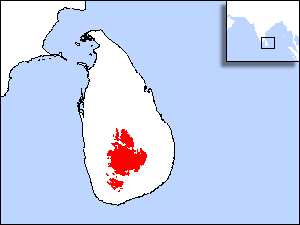
Sri Lanka Wood-pigeon
Columba torringtoni
|
Justification This pigeon has a small, declining,
population and range, which is also severely fragmented, as a result of
the destruction of hill and montane forest. It therefore qualifies as
Vulnerable. |
|
|
|
Threats The main threat is the extensive
clearance and degradation of forests, particularly in the wet zone,
through logging, fuelwood-collection, conversion to agriculture and tree
plantations, gem mining, settlement and fire. Some protected forests
continue to be degraded and suffer further fragmentation. It has also
suffered reductions in food supply because of replacement of natural
forests, containing fruiting trees, with monoculture plantations. |
|
Conservation It is legally protected in |
|
Targets *Conduct a comprehensive survey in
order to produce management recommendations for this species in
conservation forests and other protected areas. *Research its ecology,
particularly seasonal movements in response to food availability.
*Encourage protection of important areas of forest holding this and other
threatened species, including proposals to designate conservation forests,
and ensure their effective management. *Maintain the current ban on
logging of wet zone forests. *Promote programmes to create awareness of
the value of biological resources amongst local communities. |
Use Your Browser's Back Button to return to the Previous Page